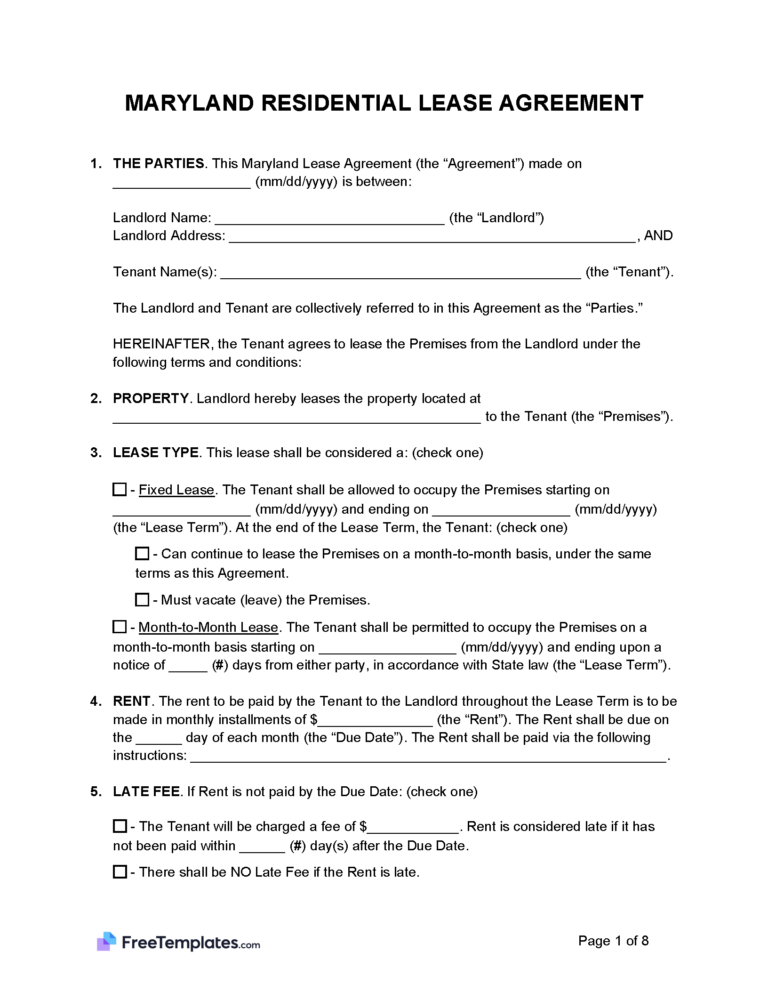By Type (6)
| Standard Lease Agreement – A contract that outlines the terms and conditions of renting a residential property for a set term, typically 12 months. |
| Commercial Lease Agreement – Similar to the standard lease agreement but for companies renting out property for business purposes. |
| Month-to-Month Lease Agreement – Short-term and flexible, this is a legally binding rental arrangement for monthly or 30-day terms. |
| Rent-to-Own Agreement – This is a standard lease agreement with an additional condition outlining the terms under which the renter will purchase the rental property from the owner. |
| Roommate Agreement – To avoid conflict between individuals sharing a residential unit, this legal arrangement outlines the responsibility of each resident. |
| Sublease Agreement -Unless the original lease specifically prohibits it, the tenant can sublease the rental unit without the landlord’s permission. While the unit is subleased, the tenant remains legally bound to the original lease and the landlord. |
Disclosures (6)
Agent/Landlord Contact Details – Whether in the written lease or posted in an obvious place on the property, the landlord must include the landlord’s name, address, and phone number or that of their authorized agent. (§8–210(a)1)
Habitability – The lease must include a statement regarding the property’s condition and confirm that the unit is fit for living with reasonable safety. (§8–208(c)1)
Lead-Based Paint Disclosure – Outlines the dangers, how to limit exposure, and identify symptoms of lead-based paint in properties built before 1978.
Move-in/Move-out Checklist – The tenant has the right to inspect the unit to make a list of preexisting conditions. The tenant also has the right to be present for the move-out inspection if they notify the landlord by certified mail of their intention to move, the date of moving, and the tenant’s new address at least 15 days before moving out. The inspection will be within 5 days before or after moving out. (§8–203(a)
Ratio Utility Billing System (RUBS) Disclosure – Landlords using RUBS must provide billing details, copies of recent utility bills, allocation method, dispute resolution process, average monthly bills, inspection rights, additional charges, and a copy of the statute. Upon written request, the landlord is required to show utility billing records. (§8–212.4(c))
Security Deposit Rights – If the tenant gives a security deposit, the landlord must inform them of their rights in writing as described under the Maryland Statute at the time of payment. (§8–203(f)1(vi))
Security Deposit
Maximum Amount – Regardless of the number of tenants, the landlord cannot charge more than 2 months’ rent for security deposit. (§8–203(b)1)
Security Deposit Receipt – The landlord must give a receipt for the security deposit collected. (§8–203(c1))
Holding – The landlord must keep the security deposit in a federally insured financial institution in Maryland. The account must be solely for security deposits and bear interest. The landlord has 30 days to deposit the funds into the account. (§8–203(d1))
Returning to Tenant – Within 45 days of the lease ending, the landlord must return the deposit with simple interest, calculated at either the daily U.S. Treasury yield curve for 1 year or 1.5% per year, whichever is greater. (§8–203(e1))
- No interest is due if the lease is less than 6 months or deposits less than $50. (§8–203(e3))
Deductions – The landlord may deduct for any damages outside of normal wear and tear, including any unpaid rent.
- Itemized List Required? Funds deducted must be itemized in a statement mailed to the tenant (§8–203(f1i))
Landlord Access
General Access – Maryland does not regulate the notice that a landlord must give a tenant before entering the rental premises. However, it is recommended that they provide at least 24 hours’ notice and enter during reasonable times.
Emergency Access – In case of emergencies, a landlord does not need to provide any notice.
Paying Rent
Grace Period – Maryland does not have a state-regulated grace period. A late fee can be instated the day after the rent is due.
Maximum Late Fee – The landlord cannot charge more than 5% of the rent due for monthly rent installments or $3 per week for no more than $12 per month for weekly leases. (§8–208(d3)
Returned Checks (NSF) – The maximum fee a landlord can impose for a bounced check is $35. (§15–803)
Withholding Rent – If the rental unit threatens life, health, or safety, a tenant may pay rent to the Maryland court until the defects have been resolved. (§8–211(a))
Reasons for Eviction (3)
Non-Payment of Rent – If the rent is not paid, the landlord can issue a 10-day notice to quit to the tenant, demanding that they pay the full rent within 10 days or move out of the rental property. The notice must be mailed, affixed to the door, or electronically if elected by the tenant. (§8–401(c))
Holdover – If the renter does not move out when the lease ends and is given proper notice, the landlord can give a written 30-day notice for the tenant to move out. (§8–402)
Non-Compliance – For non-dangerous offenses violating the lease, such as having more people live in the unit than the rental contract permits, the landlord can serve a 30-day notice to end the lease. If the tenant’s violations seriously impact the property’s or humans’ well-being and imply a “clear and imminent danger,” the landlord can give a 14-day notice to vacate the premises. (§8–402.1)

